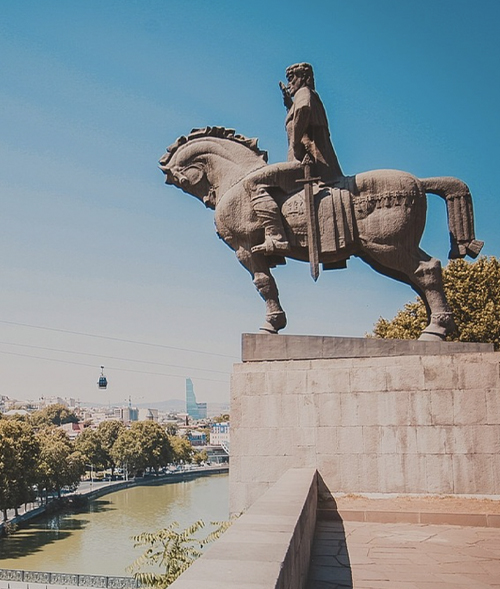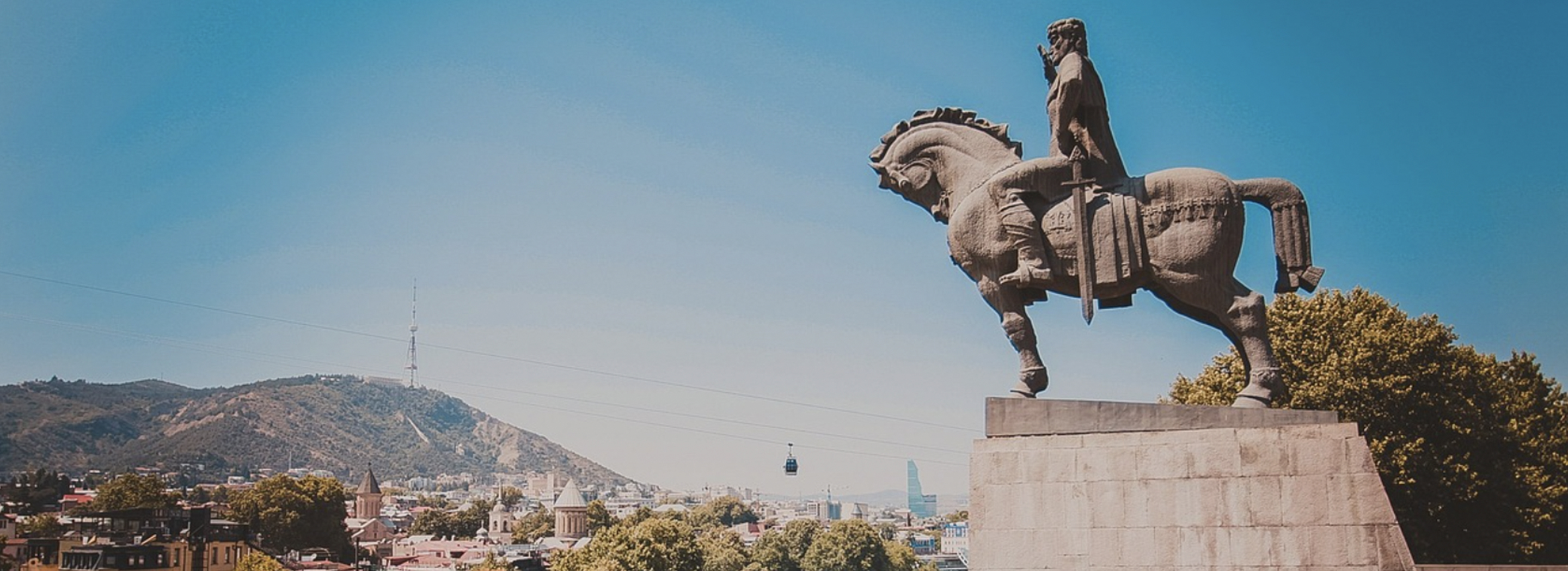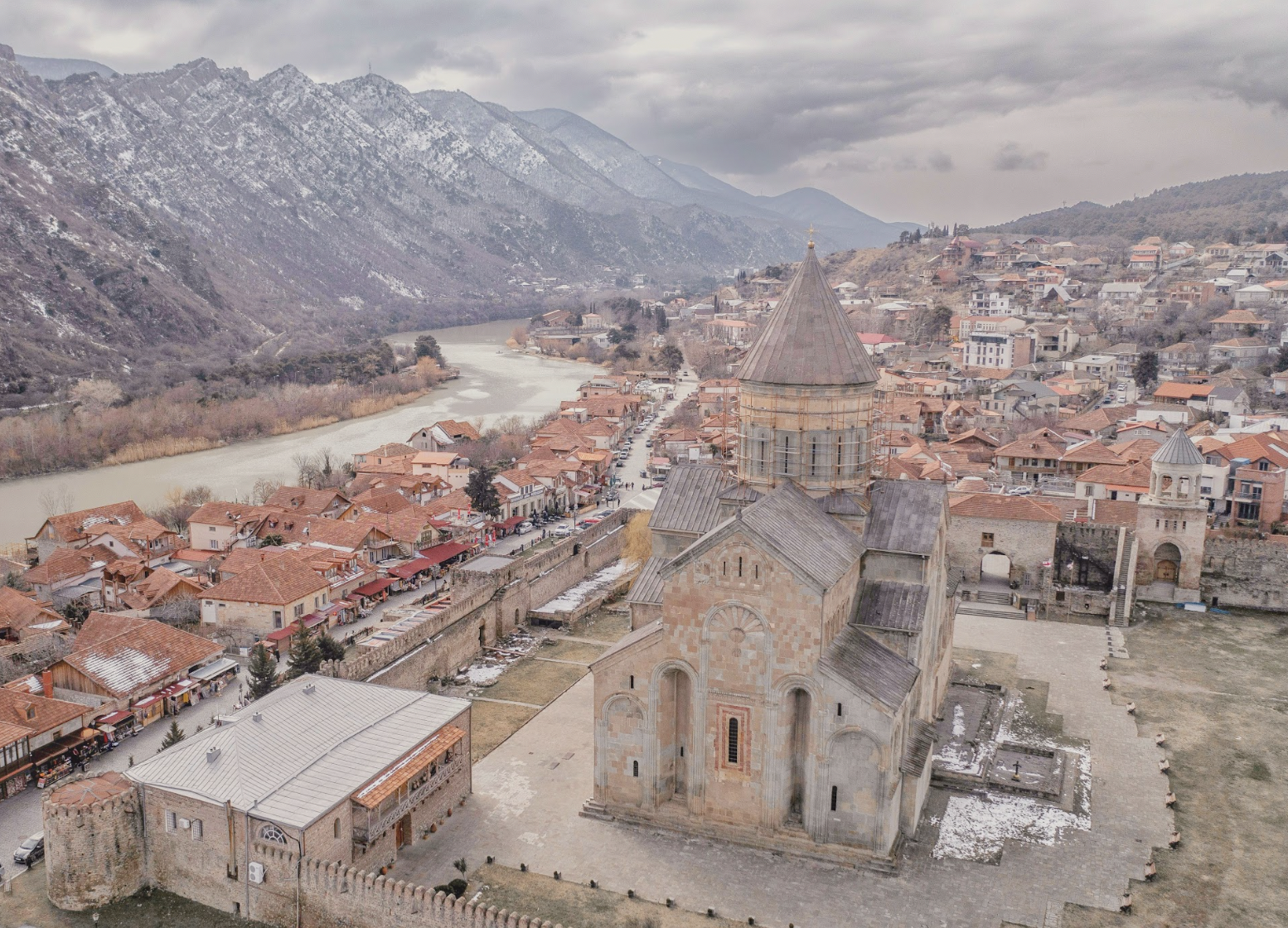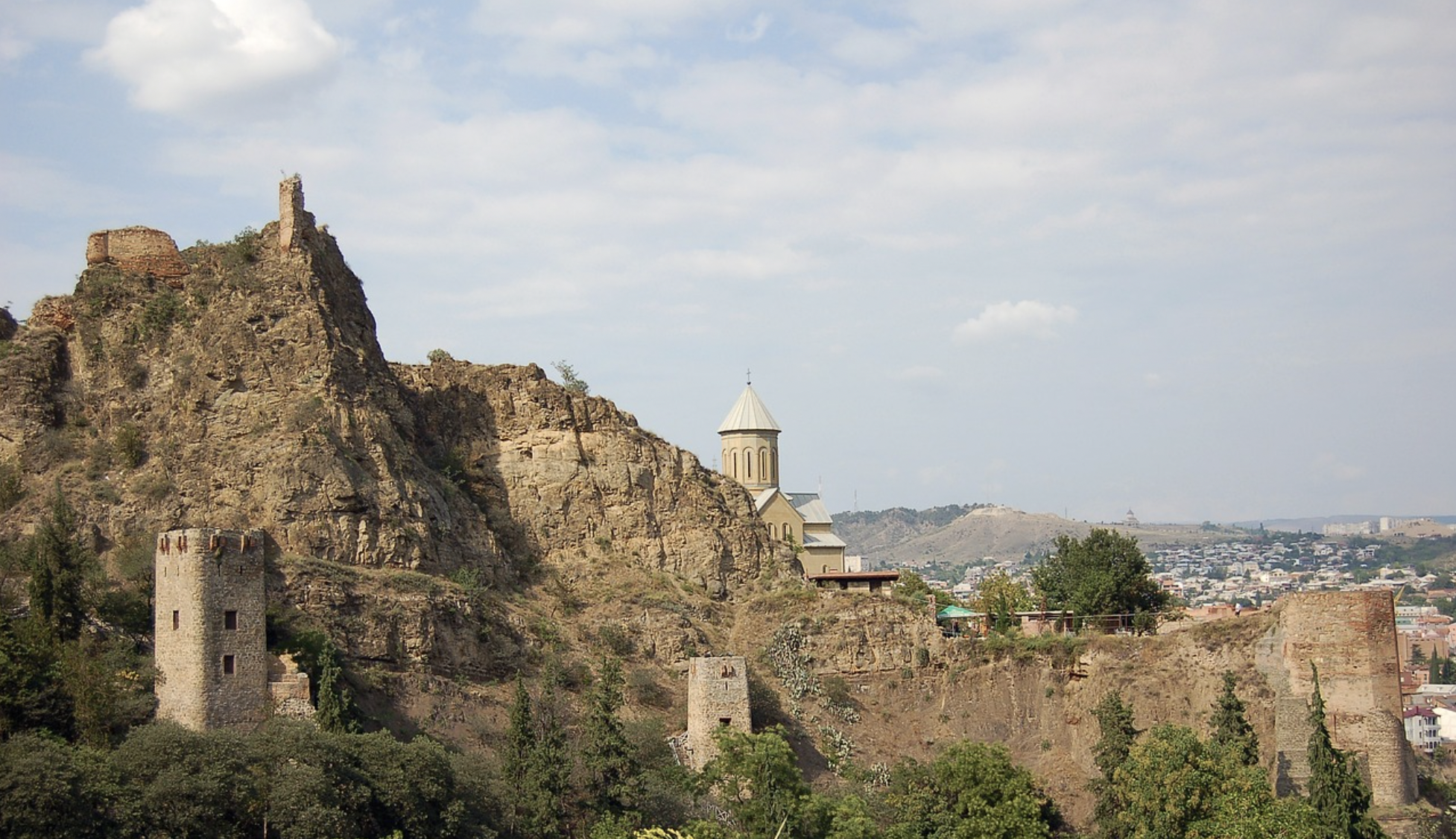
Feel free to add tags, names, dates or anything you are looking for


King Vakhtang I Gorgasali (ca. 442–502) was arguably the greatest Georgian king of late antiquity. From the early Middle Ages onwards, he became one of the main protagonists of Georgian folklore - a great king whose power could shake even the icy peaks of the Caucasus; a fierce fighter with superhuman strength and bravery. Unfortunately for scholars, most medieval accounts about King Vakhtang are predominantly legendary. However, that does not mean he did not exist and was invented later, nor is he as legendary as, say, King Arthur. Indeed, most scholars agree that King Vakhtang was a historical figure who ruled the Kingdom of Iberia in the late fifth century.
Vakhtang's father, King Mirdat V, died when Vakhtang was seven years old (ca. 449). The kingdom remained without a king while the late king’s wife, Queen Sagdukht, ruled the country. The kingdom faced many difficulties. In 452, when young Vakhtang was around ten years old, Iberia was invaded by the Alans – northern Caucasian tribesmen of Iranian origins. The Alans followed the banks of Mtkvari and burned and deserted the surrounding villages, but they did not attack the fortified cities and other parts of Iberia, except the Kaspi fortress where Vakhtang’s three-year-old sister Mirandukht was sheltered. The invaders took the fortress and captured the young Georgian princess. After Iberia, they also ravaged the neighboring Albanian kingdom.
Vakhtang longed for revenge, but had to remain patient due to his youth. When he turned fifteen, the waiting became unbearable, and he decided to act. He summoned the royal council to Mtskheta, the capital city of the Iberian kingdom, inviting both the higher and lesser nobility to his court to discuss the most important issue of the day – the invasion of the northern Caucasus and a military expedition against the Alans. Despite some opposition, the young king decided to gather troops and invade the north. With the help of his Persian uncle and his men, and a number of northern Caucasian tribesmen, Vakhtang marched north and defeated the Alans on the banks of the River Terek. This was the first victory for the young Georgian king. After the battle, Vakhtang went to the northwestern Caucasus, crushing his enemies everywhere he went. Vakhtang demanded the Alans return his sister and other Georgian captives, and the Alans agreed to do so in exchange for the release of the Alan captives. The Georgian king agreed. The Alans released Mirandukht and every prisoner they had kidnapped five years prior. In return, King Vakhtang gave them back the Alan prisoners. Vakhtang went back to Mtskheta victorious, a hero to his people, whose valor and bravery were now well-known to both friends and enemies.

Mtskheta - Capital City of the Iberian KIngdom
Not long after his return to the capital, the young king married a Persian princess. After the marriage, the Persian king demanded Vakhtang organize a military expedition to the Byzantine Empire. The main source describing Vakhtang’s life, the eighth-century work The Life of Vakhtang Gorgasali by an unknown author, describes Vakhtang’s invasion of the eastern Roman Empire. In that account, Vakhtang fights the Romans as a Persian subject, however, soon he becomes convinced that he is on the wrong side, because the Romans (Byzantines), as Christians, are the children of God, so, with the help of the local monks, Peter and Samuel, he forges an alliance with the Byzantine Empire. Historians dismiss entirely the historical reality of Vakhtang’s invasion of the Roman Empire as described in his Life, claiming that there is no compelling evidence in any sources that such a large-scale war took place between the Roman Empire and Sasanian Persia at the end of the 450s or beginning of the 460s, or that the Iberians played a crucial role in the alleged war. It seems instead to have been an invention of the medieval Georgian author. I believe this fabrication had two main goals: First, it intended to show the main sources of the Iberian king’s legitimacy, as, in the account, the King of Iberia was legitimized and blessed by the Eastern Roman Emperor. The second reason was the description of the transformation that took place in the heart and mind of the Georgian king, who realized that true legitimacy came from the Roman Empire, that Christian Romans were the true ‘children of God (because they are Christians)’ and that his loyalty should lie with the Byzantine/Eastern Roman Empire, not with ‘godless fire-worshippers,’ i.e. Persians.
Next, the author of The Life of Vakhtang Gorgasali describes how the Persian king (according to the chronology proposed by Javakhishvili, it would have been Peroz [459-484]) invaded Iberia because he had learned about the alliance between Iberia and the Roman Empire. Vakhtang took measures to prepare his people and kingdom for the invasion, fortifying the castles and cities and arming his cavalry and infantry. He sent envoys to the Eastern Roman Emperor to ask for support, but the emperor could not provide any help at that time because he had invasions to deal with himself. Thus, Vakhtang alone had to face the Sasanian army. King Vakhtang headed to Dighomi, near Mtskheta. The Persian army was encamped in a place known as Tskhenisterpi. According to The Life of Vakhtang Gorgasali, the battles between the Georgians and the Persians lasted several months, and King Vakhtang received his nickname ‘Gorgasali’ during this war. Legend says that during the fighting, Vakhtang appeared when the situation was most difficult for the Georgians. The Iberian king was already renowned as a fearsome warrior; clad in chainmail, with a huge shield, spear and sword, Vakhtang slaughtered the Persians on all sides. The Persian soldiers were terrified of his rage and gigantic stature. The enemy saw his golden helmet blazing in the sunlight, on the front of which was the figure of a wolf and on the back the figure of a lion. When the Persians saw him, they screamed in terror: ‘Dur Az Gorgasal!’, which means: ‘Flee the head of the wolf’. Hence, King Vakhtang came to be named Gorgasali. Vakhtang fought desperately. For some time he resisted the Persian invasion alone, and then, at last, the Romans came to his aid. The Roman Emperor returned from his military expedition and sent troops to Vakhtang. When the Persian king learned about the march of the Byzantine troops, he sued for peace. Vakhtang did not want to continue the bloodshed, so the war ended and Vakhtang survived the invasion.

Lost Image of King Vakhtang Gorgasali
Soon after the treaty, the Persian king asked Vakhtang to take part in a major military expedition in India. This episode of The Life of Vakhtang Gorgasali is also overwhelmingly legendary. The Life describes the Persian invasion of the distant and legendary lands of India, Sindia and Abasheti. Here, King Vakhtang is said to have once again distinguished himself as a brave warrior. Despite the fact that this episode lacks historicity, it is possible that Vakhtang was actually involved in the Persian king’s large-scale campaign that he led in the east against the Hephtalite Huns, who constantly harassed Sasanian Persia. As The Life notes, this invasion lasted eight years. After eight years, the Iberian king finally returned to his homeland.
However, not everybody was happy with Vakhtang’s return. Vakhtang’s former tutor, Bishop Michael, already knew about his former pupil’s ecclesiastical plans, that Vakhtang intended to get rid of him, an ambitious and arrogant old man, and appoint Peter, whom he had met during his Byzantine campaign, according to Vakhtang’s Life, as head of the Georgian Church. On his return, Vakhtang went to pray in church in Mtskheta and to pay a visit to his former tutor. It was customary, mandatory even, for a king to kiss the feet of the head of the Georgian Church. Vakhtang arrived at the church, but before he could enter, he was met by Bishop Michael. During their meeting, an unheard of thing happened. The enraged bishop, who knew that Vakhtang meant to replace him, kicked Vakhtang’s jaw and broke his teeth. According to one account, because of this grave insult, Vakhtang was blinded with rage, and for a moment considered eradicating Christianity from his whole kingdom. However, reason quickly calmed his temper, and instead, he sent Michael to Constantinople, where the Patriarch of Constantinople, probably Acacius, imprisoned him in a monastery.
The 460–740s were generally peaceful years for the Kingdom of Iberia, from what we can gather from the scarce sources available. Vakhtang managed to deal with internal opposition in the Church and, in an important move, transformed the powerful institution into his ally. He also made considerable changes to the administration and defensive system of the kingdom. King Vakhtang gave his son, Prince Dachi, several important districts in which the influence of Christianity was still weak, with the instruction that he was to maintain royal authority in those mountain communities where paganism was resisting the spread of Christianity. Refusal to accept Christianity had political implications for the crown- it meant that the highland communities of Iberia were defying royal orders, a potential danger that King Vakhtang dealt with. He started to rebuild the fortified city of Ujarma in Kakheti, and it became an important strategic stronghold which controlled the roads coming from the mountains, also responsible for the defense of the southern borders of Iberia.

The Fortress of Ujarma (Tower)
Another great construction initiated and led by Vakhtang Gorgasali was the foundation of Tbilisi as the new capital of the Iberian Kingdom. Until the beginning of the sixth century, Tbilisi was a small village near the fortress of Kala, which defended the road to the Iberian capital, Mtskheta. In the late fourth century, during the reign of the Georgian King Varaz-Bakur, the Persian official took Kala fortress so as to control the Iberian kingdom. In the 460s, Tbilisi, and its castle Kala, were destroyed during the war between Vakhtang and the Persians. At the end of the fifth century, King Vakhtang made an important decision: He carefully analyzed the strategic and economic importance of Tbilisi and decided to move the royal court there from Mtskheta. Thus, the building of the new capital of the Iberian Kingdom began. After the passing of centuries, a fascinating legend came about as to how the capital city of Georgia was founded, claiming that a long time ago, before Tbilisi became the capital, its territory was covered by dense forests, making it the perfect place for hunting. Legend has it that King Vakhtang, with his hunters on a hunting trip from Mtskheta, let a pheasant fly and then sent a falcon after it. The falcon chased the bird with incredible speed, but the pheasant was also fast, and the royal hunters lost sight of them. The king and his hunters galloped in the direction they had flown, and after some time, found the falcon and the pheasant boiling in a pool of hot spring water. The hunters dismounted their horses and approached the spring. The air was filled with the smell of sulfur. The king and his entourage looked around and found many other springs there, both hot and cold. They later found that the springs had healing powers. The area was beautiful and covered with dense forest, and the king decided to build a city there, and named it Tbilisi, derived from the Georgian word tbili, meaning ‘warm’. Of course, this is just a legend and does not reflect the actual historical and geopolitical circumstances that led to the founding of the city. Nor does it reflect the fact that Tbilisi was already an important settlement at the beginning of late antiquity.

Ancient Fortress of Kala (Narikala) in Tbilisi
After a period of peace, in which Vakhtang was occupied with rebuilding his kingdom, he decided to finally rid the land of the Persian oppression by starting a rebellion against Sasanian Persia. While Persian King Peroz was occupied in endless bloodshed with the Hephthalites, in 482, Vakhtang ordered his men to murder Varsken, one of the great Georgian lords who opposed Vakhtang’s authority. The royal servants brutally killed the unruly lord and sparked the rebellion. While hoping for support from the Caucasian Huns, Vakhtang was joined by the Armenians. The rebellion lasted from 482-84 and was not as successful as the Georgians and Armenians hoped. In 484, the Caucasian countries were invaded by the Persian General Zarmihr, who intended to finally crush the uprising. However, a messenger soon brought bad news to the Persian camp: King Peroz had died during his eastern campaign, the Persian army had been destroyed by the Huns and the empire was being invaded by the Hephthalites. Zarmihr immediately left the Caucasus and returned to Iran. Peroz’s brother Balash (484–488) became the new Persian king, and went on to make some concessions to his Christian subjects in the Caucasus. The main achievement for the Georgians was that King Vakhtang was allowed to stay in Iberia and continue to rule the country.
Vakhtang’s last war was the Persian invasion of Iberia in 502. According to the Life of Vakhtang Gorgasali, the Persian king demanded Vakhtang provide military assistance against the Byzantine Empire, however, Vakhtang refused, and instead prepared for another great war against the Persians. He sent heralds to every corner of his kingdom, telling his people that those living in unfortified settlements should flee to the Caucasian mountains or to the mountainous areas of Kakheti. Prince Dachi, with his nephew, also went to Kakheti, to the valley of Lopoti, which was surrounded by cliffs and rocks. Vakhtang’s Byzantine wife, Helen, two sons, and a daughter which he had fathered with Helen, stayed in Ujarma. The king himself went to the citadel with his loyal noblemen Juansher and Adarnase, leaving Mtskheta to be defended by his old friends Demetre, Nerse and Bivritiani. Vakhtang also sent envoys to the Byzantine Emperor to ask for help against the invader.
The Persian army first invaded the district of Kambechovani (modern Kiziqi) and sacked the fortresses of Cheremi and Velistsikhe. Then they advanced to the banks of the Iori, where they were met by Vakhtang’s army. The bloody battle went on for three days. Vakhtang was as valiant and fearsome as ever he had been in those early days when he gained his nickname in terrifying his enemies. The night before the major battle, Vakhtang left part of his infantry on the cliffs and took the rest of his men down to face the enemy head-on. As the darkness of night and the mist of dawn dispersed, Vakhtang turned to his soldiers and warned them: ‘Every man who escapes death and does not bring back either a head or a hand of one of our enemies will be put to death by us.’ Vakhtang sliced through the Persian troops and attacked the tent where the Persian king was staying. While the Persian king managed to escape Vakhtang’s sword, the Georgian king did manage to kill a Persian prince named Bartman and cut off his head. Victory belonged to the Georgians; however, it was not a complete victory.

Modern Statue of Vakhtang Gorgasali in Tbilisi
There are several legends about how Vakhtang came to be wounded in the battle. The Life of Vakhtang Gorgasali says he was shot by an arrow that pierced his lung and caused a mortal wound. A later legend claims that one of the Vakhtang’s former Persian slaves knew that his chainmail was torn at his armpit. The treacherous slave had a keen eye, and he was an excellent archer. When the king raised his arm to swing his sword, the slave shot an arrow into his armpit. The king fell to one knee, unable to continue to fight. The Georgian soldiers encircled the king and took him from the battlefield to Ujarma. The Georgians won the battle, but the Persians were not completely defeated: The Persian king set up camp in Rustavi, from where he led an assault on Mtskheta. He was not able to sack the old capital, however, merely to ravage its surroundings, the newly established Tbilisi, Armazi, and areas of Mukhrani. The dying King Vakhtang issued an order to his son and commanders from Ujarma, warning them to stand fast, defend their strongholds, and not to allow the enemy to pass through the kingdom. They did so, and not long after, the Persian king was forced to leave Iberia.
Vakhtang died in Ujarma, and his body was taken to Mtskheta for burial. Vakhtang's image remained in the memory of his people for centuries; his courage and heroic deeds encouraged and inspired Georgians in their bloody wars for their country’s independence. The medieval flag of Georgia was called Vakhtangian-Davitian-Tamariani i.e., the flag of Vakhtang, David and Tamar, the three greatest monarchs of medieval Georgia. For centuries, Vakhtang’s name was shrouded in legends and folktales, seeing him imagined as a king who fought not only the human enemy, but also the forces of darkness; a man who was able to win in the name of God. However, even if we talk about Vakhtang just as a historical figure, he was indeed one of the greatest kings of ancient Georgia, and he played a crucial role in the political, economic and cultural life of the Iberian kingdom.